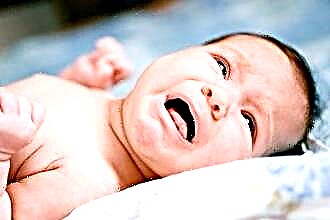Snot in a child - what could be more often? They appear at any time with different frequency and intensity, being a manifestation of infectious and non-infectious diseases. A runny nose and temperature in a child indicate infection of the body and the development of intoxication.
 Often the cause of the common cold are pathogenic microorganisms of the viral and bacterial species. When breathing through the nose, pathogens can settle on the nasopharyngeal mucosa, thereby damaging it. Due to the development of the inflammatory process, the mucous membrane becomes hyperemic and edematous, making nasal breathing difficult.
Often the cause of the common cold are pathogenic microorganisms of the viral and bacterial species. When breathing through the nose, pathogens can settle on the nasopharyngeal mucosa, thereby damaging it. Due to the development of the inflammatory process, the mucous membrane becomes hyperemic and edematous, making nasal breathing difficult.
The toxins released by microbes provoke the production of mucus, from which rhinorrhea appears. Rhinitis in most cases accompanies adenovirus, rhinovirus infection and influenza.
Non-infectious causes of the common cold are:
- a traumatic factor (blow, thorough cleansing of the mucous membrane);
- allergens (pollen, dust, wool, perfume, household chemicals);
- a low level of immune defense due to severe co-infection (HIV), systemic diseases (diabetes, lupus), or poor diet;
- hypothermia. When children are exposed to cold rain or freeze, the risk of rhinorrhea increases as a sign of general hypothermia. In addition, with prolonged frequent inhalation of cold air, the blood vessels of the nasopharyngeal mucosa spasm, reducing local protection and predisposing to infection;
- inhalation of polluted air with dust particles or aggressive substances that irritate the nasopharyngeal mucosa, causing inflammation.
The severity of the symptoms of the disease depends on the strength of the provoking factor and the resistance of the immune defense.
An increase in temperature indicates an infection of the body.
Clinical manifestations
Children at an early stage of the development of the disease may complain of itching in the nose, which makes them sneeze constantly. Dryness of the mucous membrane and perspiration in the nasopharynx may appear. These signs can be observed for 1-2 days, after which the symptoms worsen. Inflammation of the mucosa leads to an increase in mucosal edema, hypersecretion and the release of copious watery mucus. Further manifestations are presented:
- shortness of breath;
- altered taste;
- discomfort in the nose due to swelling of the mucous membrane;
- decrease or complete absence of smell;
- Clapping and tinnitus. The appearance of this symptom indicates swelling of the mucous membrane of the auditory tube, due to which its airway function is impaired and pressure drops are observed.
Of the general symptoms, it is worth highlighting the lethargy, inattention, tearfulness of the child, which is due to intoxication and impaired nasal breathing. Against the background of treatment, the mucous discharge gradually becomes thicker, and when bacterial pathogens are attached, they acquire a greenish tint.
Snot and temperature in a child can appear at the same time, if we are talking about an infectious process. The severity of the fever depends on the type of pathogen:
- a viral infection provokes an increase in hyperthermia to 38-39 degrees in the first 2 days, after which the temperature of 38 degrees becomes the upper limit of fever. Basically, the temperature is kept at 37.4 degrees;
- bacterial pathogens can damage the nasopharyngeal mucosa during initial contact or against the background of viral rhinitis. Fever can reach 39.5 degrees and be kept at a high level until the start of taking antibacterial drugs or complete sanitation of the infectious and inflammatory focus.
If rhinitis develops in infants, nasal congestion and lack of nasal breathing make it difficult to suck on the breasts or nipples, which may lead to weight loss, poor sleep and the baby's moodiness.
Let us consider separately the manifestations of an allergic reaction. After contact of a child with an allergen, rhinorrhea, lacrimation, itching of the eyes, skin, rashes, shortness of breath due to swelling of the respiratory tract mucosa, and diarrhea may appear.
Complications of the common cold
Prolonged absence of nasal breathing can lead to hypoxia and disruption of the formation of the facial skeleton in children.
Insufficient oxygen supply to the internal organs predisposes them to dysfunction. As a result, developmental delays, impaired cognitive functions of the brain, and sleep problems appear.
Children with chronic sinusitis, a deviated septum, or frequent allergies become inattentive, do poorly at school, and are depressed.
On the other hand, the persistence of a bacterial infection in the nasopharynx is fraught with its spread to the mucous membrane of the Eustachian tube with the development of tubootitis, as well as the oropharynx, increasing the risk of pharyngitis or tonsillitis.
Diagnostic measures
When a child has snot and fever, medical diagnostics is aimed at establishing the cause of rhinitis and assessing the severity of the disease. Based on the analysis of symptoms and data from laboratory and instrumental diagnostics, treatment tactics are determined. Evaluation of the child may include:
 rhinoscopy;
rhinoscopy;- blood test;
- X-ray examination of the paranasal sinuses and chest;
- immunological analysis, allergy tests - if you suspect an allergic origin of the common cold;
- sowing of discharge from the nose, which allows you to establish the type of pathogen and select effective drugs.
With a complicated course of the disease, otoscopy or pharyngoscopy may be prescribed to assess the prevalence of the inflammatory process.
How is a common cold treated?
If the temperature is 37, snot appears in the child, and the general condition practically does not change, it is enough to use the methods of local therapy. With an increase in hyperthermia, the appearance of symptoms of intoxication and an increase in the common cold, the use of drugs with a systemic effect is required.
| A drug | Action | Dose | Note |
|---|---|---|---|
| Aqua Maris | Reduces irritation of the mucous membrane, mucus secretion and clears it of allergens, dust, improves the functioning of the ciliated epithelium. | Allowed from birth (in the form of drops), after a year, a spray is allowed. Enough 1-2 drops in each nasal passage 3-4 times a day. | Rinsing of the nasal cavities can be carried out with No-salt, Salin or Humer solutions. From herbal decoctions, you can use chamomile, sage or St. John's wort. |
| Vibrocil | Cleans the nasal passages, reduces mucus production and mucosal swelling. | Allowed from 6 years (in the spray handicap), up to six years of age, drops are recommended. It is used 1 injection into each nasal passage no more than three times a day. The maximum treatment course is 7 days. | Lazorin, Otrivin, Nazivin are also allowed. |
| Panadol | Normalizes temperature and has a slight analgesic effect. | Used from birth. Once you can give 2.5 ml of suspension, no more than twice a day (up to three months of age), then the dose and frequency of administration increases. | Ibuprofen, Efferalgan is also allowed. |
| Novirin | Antiviral action. | The dose is calculated based on the weight of the child. For one kilogram, 50 mg of the drug is prescribed (this is a daily dose, which should be divided into 2-3 doses). The medicine is applied from one year. | It is prescribed for a viral infection. Amiksin, Citovir, Otsilokoktsinum or Amizon are also allowed. |
| Sumamed | Antibacterial action. | Reception 1 time per day at the rate of 0.25 ml per kilogram of weight. The powder is dissolved in cooled boiled water. | It is prescribed for bacterial inflammation. Amoxiclav or Cefuroxime are also allowed. |
In order for drug treatment to lead to a positive result in a short time, some recommendations should be followed:
- limitation of physical activity;
- proper vitamin nutrition;
- enhanced drinking regime;
- wet cleaning and air humidification;
- lack of contact with sick peers;
- hypothermia prevention.
Comprehensive treatment allows you to overcome the infection, which makes the cold recede and the symptoms of the disease go away. The frequency of ARVI can be reduced by strengthening the child's immunity by hardening, changing the climate and timely treatment of infectious diseases.

 Prolonged absence of nasal breathing can lead to hypoxia and disruption of the formation of the facial skeleton in children.
Prolonged absence of nasal breathing can lead to hypoxia and disruption of the formation of the facial skeleton in children. rhinoscopy;
rhinoscopy;

